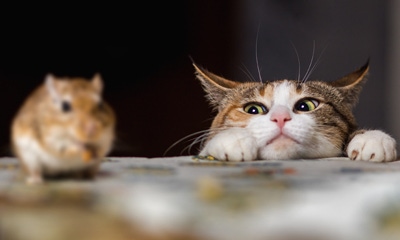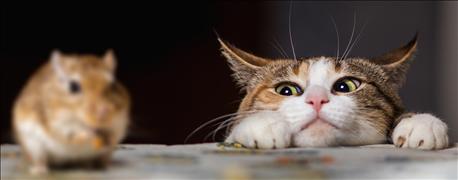
Anyone who has raised livestock has seen a mouse or two. I’m not allowed to call them mice. Our youngest daughter is so paranoid — one of those unnatural fears we all have but seldom own up to — that even hearing the word "mouse" sends her into a frenzy. On our farm, they’re "creatures."
I’ve lived with a few creatures over the years. So many, actually, that they once chewed up wiring and nearly caused a barn fire. But over the past couple of years they’ve been rather scarce. And we haven’t even had a cat for a while. Cats aren’t our favorite animals. Like they say, dogs have masters; cats have servants.

MOUSE PROBLEM: Nothing controls a creature problem like a good farm cat. (Photo credit: zsv3207/iStock/Thinkstock)
But this past spring the creatures returned. When I got down to the last few sacks of feed, grain was spilling out because the sacks were chewed. I saw a couple of creatures run off. I cleaned up the grain before I brought in new feed.
Then one time there were three chewed sacks. Finally, the last time, four sacks were chewed up, and mice ran everywhere. The creatures were out of control.
Cleanup begins
Enough is enough. Especially since we were going on a trip, and our daughter would need to go in the barn to feed the sheep. As it turns out, she farmed that chore out to a friend. Nevertheless, I decided to clean up the mess before we left.
Once I pulled up the wooden pallets the sacks sat on, I figured out my problem. It was creature paradise, and they went scurrying everywhere — big ones, little ones, way too many.
So I scooped up the mess, cleaned it down to the floor, and Carla, my wife, and I headed off to a big box rural supply store. We came home armed with a Tin Cat and a whole pail of bait. Creatures go in the Tin Cat, and they don’t come out. At least that’s the theory.
I placed the mechanical cat in an obscure place where my daughter wouldn’t see it easily, and even camouflaged it with an empty feed sack. Meanwhile, Carla and I discussed something I thought was off limits: getting a cat!
“What you need is a barn cat,” my elderly neighbor agreed. He may be old, but his advice is solid. “Make sure it’s a female. They’re the hunters. Tomcats just play around.”
We stopped by a neighbor’s place that same day, and as luck would have it, they had a farm cat with three kittens. They said they'd be more than happy to part with the kittens as soon as they’re old enough.
Cat time
So we went on our trip. Our daughter left the feeding and creature patrol to her friend.
Modern technology has its downside. I don’t think the person who invented a phone you can send pictures on envisioned me getting a text from the barn steward with a photo of the inside of the creature trap — before he dumped it out!
Worse yet, he posted the photo on Instagram, whatever that is. I hark back to when times were simpler, and we told stories like these sitting on the front porch with the neighbors, not over social media.
Sitting on the porch, we would talk more about getting cats. I’m ready for those kittens to get big enough to come make their home in our barn. After all, tin cats eventually rust.
Bring on the cats! Besides, I will have three more possibilities for fodder to talk about while sitting on the Front Porch!
About the Author(s)
You May Also Like




